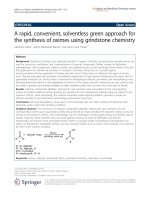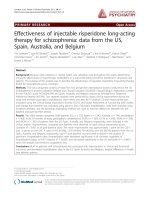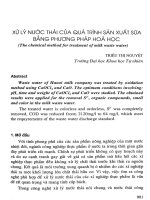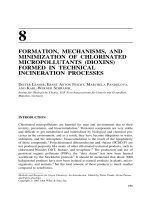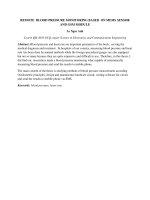Sanjay k sharma green chemistry for dyes removal from waste water research trends and applications wiley scrivener (2015)
Bạn đang xem bản rút gọn của tài liệu. Xem và tải ngay bản đầy đủ của tài liệu tại đây (4.92 MB, 492 trang )
www.pdfgrip.com
Green Chemistry for Dyes
Removal from Wastewater
www.pdfgrip.com
Scrivener Publishing
100 Cummings Center, Suite 541J
Beverly, MA 01915-6106
Publishers at Scrivener
Martin Scrivener()
Phillip Carmical ()
www.pdfgrip.com
Green Chemistry for
Dyes Removal from
Wastewater
Research Trends and Applications
Edited by
Sanjay K. Sharma, FRSC
www.pdfgrip.com
Copyright © 2015 by Scrivener Publishing LLC. All rights reserved.
Co-published by John Wiley & Sons, Inc. Hoboken, New Jersey, and Scrivener Publishing LLC, Salem,
Massachusetts.
Published simultaneously in Canada.
No part of this publication may be reproduced, stored in a retrieval system, or transmitted in any form or
by any means, electronic, mechanical, photocopying, recording, scanning, or otherwise, except as permitted under Section 107 or 108 of the 1976 United States Copyright Act, without either the prior written permission of the Publisher, or authorization through payment of the appropriate per-copy fee to
the Copyright Clearance Center, Inc., 222 Rosewood Drive, Danvers, MA 01923, (978) 750-8400, fax
(978) 750-4470, or on the web at www.copyright.com. Requests to the Publisher for permission should be
addressed to the Permissions Department, John Wiley & Sons, Inc., 111 River Street, Hoboken, NJ 07030,
(201) 748-6011, fax (201) 748-6008, or online at />Limit of Liability/Disclaimer of Warranty: While the publisher and author have used their best efforts
in preparing this book, they make no representations or warranties with respect to the accuracy or
completeness of the contents of this book and specifically disclaim any implied warranties of merchantability or fitness for a particular purpose. No warranty may be created or extended by sales representatives or written sales materials. The advice and strategies contained herein may not be suitable for your
situation. You should consult with a professional where appropriate. Neither the publisher nor author
shall be liable for any loss of profit or any other commercial damages, including but not limited to special, incidental, consequential, or other damages.
For general information on our other products and services or for technical support, please contact
our Customer Care Department within the United States at (800) 762-2974, outside the United States at
(317) 572-3993 or fax (317) 572-4002.
Wiley also publishes its books in a variety of electronic formats. Some content that appears in print may
not be available in electronic formats. For more information about Wiley products, visit our web site
at www.wiley.com.
For more information about Scrivener products please visit www.scrivenerpublishing.com.
Cover design by Russell Richardson
Library of Congress Cataloging-in-Publication Data:
ISBN 978-1-118-72099-8
Printed in the United States of America
10 9 8 7 6 5 4 3 2 1
www.pdfgrip.com
This book is for Kunal – Kritika….my twin angels on their
15th Birthday, with love.
www.pdfgrip.com
www.pdfgrip.com
Contents
Preface
Acknowledgements
About the Editor
xiii
xix
xxi
1. Removal of Organic Dyes from Industrial Effluents:
An Overview of Physical and Biotechnological
Applications
Mehtap Ejder-Korucu, Ahmet Gürses, Çetin Doğar,
Sanjay K. Sharma and Metin Aỗkyldz
1.1 Introduction
1.1.1 Dyes
1.1.2 Historical Development of Dyes
1.1.3 Natural Dyes
1.2 Classification of Dyes
1.3 Technologies for Color Removal
1.3.1 Chemical Methods
1.3.2 Physical Methods
1.3.3 Biological Methods
References
2. Novel Carbon-Based Nanoadsorbents for Removal of
Synthetic Textile Dyes from Wastewaters
Shamik Chowdhury, Rajasekhar Balasubramanian and
Papita Das
Acronyms
2.1 Introduction
2.2 Basic Properties of Carbon Nanoadsorbents
2.2.1 Carbon Nanotubes
2.2.2 Graphene
2.3 Adsorpton of Textile Dyes by Carbon Nanoadsorbents
vii
www.pdfgrip.com
1
2
3
4
5
5
10
12
12
18
22
35
35
36
37
37
40
44
viii Contents
2.3.1 Adsorption by CNTs and Their Composites
2.3.2 Adsorption by Graphene and Its Related Materials
2.4 Mechanism of Dye Adsorption onto Carbon-Based
Nanoadsorbents
2.5 Conclusion and Future Perspectives
References
44
59
73
74
76
3. Advanced Oxidation Processes for Removal of Dyes from
Aqueous Media
83
Süheyda Atalay and Gülin Ersöz
3.1 Introduction
84
3.2 Advanced Oxidation Processes
85
3.2.1 Nonphotochemical Advanced Oxidation Processes 87
3.2.2 Photochemical Advanced Oxidation Processes
102
3.3 Concluding Remarks
109
References
110
4. Photocatalytic Processes for the Removal of Dye
Pankaj Chowdhury, Ali Elkamel and Ajay K. Ray
4.1 Introduction
4.2 Photocatalysis – An Emerging Technology
4.3 Photo-Oxidation Mechanism
4.4 Solar Photocatalysis/Photoreactors
4.5 Solar Photoreactor for Degradation of
Different Dyes
4.6 Dependence of Dye Degradation on Different
Parameters
4.6.1 Effect of Photocatalyst Loading
4.6.2 Effect of Initial Dye Concentration
4.6.3 Effect of Solution pH
4.6.4 Effect of Light Intensity
4.6.5 Effect of Electron Scavenger
4.7 Conclusions
Acknowledgement
References
5. Removal of Dyes from Effluents Using Biowaste-Derived
Adsorbents
Pejman Hadi, Sanjay K. Sharma and Gordon McKay
5.1 Introduction
www.pdfgrip.com
119
119
125
126
126
128
129
131
131
132
133
133
134
134
135
139
140
Contents
5.2 Agro-Based Waste Materials as Dye Adsorbents
5.2.1 Rice Husk
5.2.2 Bagasse
5.2.3 Peat
5.2.4 Bamboo
5.2.5 Date Pits
5.2.6 Palm Tree Waste
5.2.7 Coconut
5.2.8 Tea and Coffee
References
6. Use of Fungal Laccases and Peroxidases for Enzymatic
Treatment of Wastewater Containing Synthetic Dyes
Keisuke Ikehata
6.1 Introduction
6.2 Textile Dyes – Classifications, Chemical Structures and
Environmental Impacts
6.2.1 Classification of Dyes
6.2.2 Chemical Structures
6.2.3 Environmental Impacts
6.3 Biodegradation of Synthetic Dyes by White Rot Fungi
6.3.1 Earlier Fungal Decolorization Studies with
Phanerochaete chrysosporium
6.3.2 Other White Rot Fungi
6.3.3 Bioreactors and Real Wastewater Treatment
6.4 Fungal Decolorization Mechanisms and Involvement
of Ligninolytic Enzymes
6.5 Classification and Enzymology of Ligninolytic Enzymes
6.5.1 Peroxidases
6.5.2 Fungal Laccases
6.6 Enzymatic Treatment of Synthetic Dyes
6.6.1 Lignin Peroxidases
6.6.2 Manganese-Dependent Peroxidases
6.6.3 Laccases
6.7 Concluding Remarks
Acknowledgements
References
www.pdfgrip.com
ix
142
142
150
153
157
161
168
175
180
192
203
203
205
205
206
208
213
216
217
217
219
220
220
227
228
230
231
232
237
248
248
x Contents
7. Single and Hybrid Applications of Ultrasound for
Decolorization and Degradation of Textile Dye
Residuals in Water
Nilsun H. Ince and Asu Ziylan
7.1 Overview of the Textile Industry, Dyestuff and
Dyeing Mill Effluents
7.2 Sonication: A Viable AOP for Decolorizing/
Detoxifying Dying Process Effluents
7.2.1 Sonochemical Degradation of Azo Dyes
7.2.2 Operation Parameters in Decolorization/
Degradation of Textile Dyes by Ultrasound
7.2.3 Addition of Chemical Reagents
7.2.4 Reactors
7.3 Hybrid Processes with Ultrasound:
A Synergy of Combinations
7.3.1 Sono-Ozonolysis (US/O3)
7.3.2 Sonophotolysis (US/UV) and SonophotoOzonolysis (US/UV/O3)
7.3.3 Sono-Fenton (US/Fe2+) and Sonophoto-Fenton
(US/UV/Fe2+)
7.3.4 Sonocatalysis
7.3.5 Sonoelectrocatalysis
7.4 Conclusions
References
8. Biosorption of Organic Dyes: Research Opportunities and
Challenges
Guilherme L. Dotto, Sanjay K. Sharma and Luiz A. A. Pinto
Acronyms
8.1 General Considerations
8.1.1 Dye-Containing Effluents
8.1.2 Technologies for Dye Removal
8.1.3 General Aspects of Biosorption
8.2 Biosorbents
8.2.1 Agricultural Wastes
8.2.2 Algae Biomass
8.2.3 Bacterial Biomass
8.2.4 Chitosan
8.2.5 Fungal Biomass
www.pdfgrip.com
261
262
265
266
269
273
274
274
274
279
280
281
285
285
286
295
295
296
296
297
297
299
299
301
303
304
306
Contents
8.3
Factors Affecting Biosorption
8.3.1 pH
8.3.2 Temperature
8.3.3 Biosorbent Dosage
8.3.4 Particle Size
8.3.5 Contact Time
8.3.6 Initial Dye Concentration
8.3.7 Stirring Rate
8.4 Biosorption Isotherms, Thermodynamics and Kinetics
8.4.1 Equilibrium Isotherms
8.4.2 Thermodynamic Parameters
8.4.3 Kinetic Models
8.5 Future Perspectives and Challenges
References
9. Dye Adsorption on Expanding Three-Layer Clays
Tolga Depci and Mehmet S. Çelik
9.1 Introduction
9.2 Classification of Dyes
9.2.1 Anionic Dye
9.2.2 Cationic Dyes
9.3 The Expanding Three-Layer Clay Minerals and Dye
Adsorption
9.3.1 Removal of Anionic Dyes by Expanding
Three-Layer Clays
9.3.2 Removal of Cationic Dyes by Expanding
Three-Layer Clays
9.3.3 Effect of Ionic Strength on Uptake of Anionic
and Cationic Dyes
9.3.4 Adsorption Kinetics
9.3.5 Adsorption Isotherms
9.3.6 Adsorption Thermodynamics
9.4 General Remarks
References
10. Non-conventional Adsorbents for Dye Removal
Grégorio Crini
10.1 Introduction
10.2 Activated Carbons from Solid Wastes
10.3 Clays
www.pdfgrip.com
xi
308
308
309
310
310
311
312
312
313
313
317
318
322
323
331
331
334
334
334
336
337
342
344
344
346
349
352
353
359
359
362
364
xii Contents
10.4 Siliceous Materials
10.5 Zeolites
10.6 Agricultural Solid Wastes
10.7 Industrial Byproducts
10.8 Peat
10.9 Chitin and Chitosan
10.10 Biomass
10.11 Starch-Based Derivatives
10.12 Miscellaneous Adsorbents
10.13 Concluding Remarks
References
367
369
371
373
375
377
380
383
385
388
389
11. Hen Feather: A Remarkable Adsorbent
for Dye Removal
Alok Mittal and Jyoti Mittal
11.1 Introduction
11.2 Adsorbate Materials – Azo Dyes
11.2.1 Tartrazine
11.2.2 Amaranth
11.2.3 Dye Procurement
11.3 Adsorbent Material – Hen Feather
11.3.1 Development of Adsorbent Material
11.3.2 Characterization of Adsorbents
11.4 Preliminary Investigations
11.4.1 Experimental Methodology
11.4.2 Results and Discussions
11.5 Adsorption Isotherm Models
11.5.1 Adsorption and Adsorption Isotherm Models
11.5.2 Experimental Methodology
11.5.3 Results and Discussions
11.6 Kinetics Measurements
11.6.1 Theory of Kinetic Measurements
11.6.2 Experimental Methodology
11.6.3 Results and Discussions
11.7 Conclusions
References
410
413
414
416
417
417
419
419
420
421
423
427
428
434
434
441
442
446
446
451
452
Index
459
www.pdfgrip.com
409
Preface
Writing a preface for a book always has been a challenge as things are to be
looked upon not only from the eyes of an editor, but also from a reader’s
perception and expectations; all the while keeping in mind not to do any
injustice to the zeal of a contributor who has worked so hard to pen the
text.
“Green Chemistry” two decade’s old philosophy, has been attracting the
attention of scientists worldwide. Academicians as well as industrialists are
equally interested in this new stream of chemical science. Researchers, all
over the world, are conducting active research in different fields of engineering, science and technology by adopting green chemistry principles
and methodologies to devise new processes with a view towards helping, protecting, and ultimately saving the environment of our planet from
further anthropogenic interruptions and damage. Achieving sustainability and renewability of resources is the basic spirit of green chemistry;
it inspires us to try alternative “green” approaches in place of traditional
“gray” practices in everyday industrial and scientific activities.
Water pollution is a matter of great concern. It’s quality and potability
is equally important for both domestic purposes and industrial needs. But,
at the same time, industrial effluents pollute the available water resources.
Dyes, as one of the pollutants, cause various serious health hazards and
socioeconomic problems. It spoils the “productivity” of soil; which in turn
may be the reason for other related issues, especially in developing countries. Removal of dyes from water or wastewater is therefore an important
task. But, removing dyes at a cost to the environment should be avoided
when considering which technique to use. So, the far important challenge
is to make a removal technique sufficiently “green.”
Water pollution is often discussed with respect to various pollutants and
their treatments, but water pollution due to the presence of synthetic dyes
has not been discussed sufficiently in the literature. So, the treatment of
wastewater produced from industries using dyes (directly or indirectly)
xiii
www.pdfgrip.com
xiv
Preface
has tremendous scope worldwide. That is why dye removal is an important
issue which needs to be addressed seriously.
The chapters in this book are the outcome of the scholarly writing of
researchers of international repute with stellar credentials, who have tried
to present an overview of the problem and its solution from different angles.
These problems and solutions are presented in a genuinely holistic way using
valuable research-based text from world-renowned researchers. Discussed
herein are various promising techniques to remove dyes, including the use
of nanotechnology, ultrasound, microwave, catalysts, biosorption, enzymatic
treatments, advanced oxidation processes, etc., all of which are “green.” The
book contains eleven chapters, all of which focus on the theme of green
chemistry and discuss tools and techniques which are eco-friendly, nonhazardous and, moreover, low waste generating.
The textile industry produces a large amount of dye effluents which are
highly toxic as they contain a large number of metal complex dyes. The use
of synthetic chemical dyes in various industrial processes, including paper
and pulp manufacturing, plastics, dyeing of cloth, leather treatment and
printing, has increased considerably over the last few years, resulting in
the release of dye-containing industrial effluents into the soil and aquatic
ecosystems. The textile industry generates highly polluting wastewaters and
their treatment is a very serious problem due to high total dissolved solids
(TDS), presence of toxic heavy metals, and the non-biodegradable nature of
the dyestuffs present in the effluent. There are many processes available for
the removal of dyes by conventional treatment technologies including biological and chemical oxidation, coagulation and adsorption, but they cannot
be effectively used individually. Different types of dyes, their working and
methodologies and various physical, chemical and biological treatment
methods employed so far are comprehensively discussed in Chapter 1.
Adsorption is widely acknowledged as the most promising and efficient
method because of its low capital investment, simplicity of design, ease of
operation, insensitivity to toxic substances and ability to remove pollutants
even from diluted solutions. In recent years, nanotechnology has introduced a myriad of novel nanomaterials that can have promising outcomes
in environmental cleanup and remediation. Particularly, carbon-based
nanomaterials such as carbon nanotubes and graphene are being intensively studied as new types of adsorbents for removal of toxic pollutants
from aquatic systems. This extraordinary interest stems from their unique
morphology, nanosized scale and novel physicochemical properties. Thus,
Chapter 2 focuses on the use of nanotechnology in the treatment of dye
removal.
www.pdfgrip.com
Preface
xv
Textile dyeing industries expend large volumes of water, which is ultimately discharged with intense color, chemical oxygen demand (COD),
suspended/dissolved solids and recalcitrant material as unfixed dye
residuals and spent auxiliaries. A typical reactive dyebath effluent contains 20–30% of the input dye mass (1500–2200 mgL-1) and traces of
heavy metals (i.e., cobalt, chromium and copper) that arise from the
use of metal-complex azo dyes. The challenge to destroy dye residuals in
biotreated wastewater effluents seems to be resolved by the introduction
of advanced oxidation processes (AOP), whereby highly reactive hydroxyl
radicals are generated chemically, photochemically and/or by radiolytic/
sonolytic means. Hence, AOPs not only offer complete decolorization of
aqueous solutions without the production of huge volumes of sludge, but
also promise a considerable degree of mineralization and detoxification of
the dyes and their oxidation/hydrolysis byproducts. The potential of ultrasound as an AOP is based on cavitation phenomenon, i.e., the formation,
growth and implosive collapse of acoustic cavity bubbles in water and the
generation of local hot spots with very extreme temperatures and pressures. Application of AOPs in dye removal is comprehensively discussed
in Chapters 3 and 7.
The heterogeneous photocatalysis process has shown huge potential for
water and wastewater treatment over the last few decades. Chapter 4 summarizes the photocatalytic oxidation process for dye degradation under
both UV and visible light, application of solar light and solar photoreactor
in dye degradation, and then finally discusses the dependence of different
parameters (pH, photocatalyst loading, initial dye concentration, electron
scavenger, light intensity) on dye degradation.
Several technologies have been developed to treat dye-containing effluents (DCEFs) such as coagulation-flocculation, filtration, sedimentation,
precipitation-flocculation, electrocoagulation-electroflotation, biodegradation, photocatalysis, oxidation, electrochemical treatment, membrane
separation, ion-exchange, incineration, irradiation, advanced oxidation,
bacterial decolorization, electrokinetic coagulation and adsorption on
activated carbon. From an industrial viewpoint, no single process provides adequate treatment, being that significant reduction of expenses and
enhancement of dye removal can be achieved by the combination of different methods in hybrid treatments. “Biosorption” can be employed to treat
DCEFs because it combines the advantages of adsorption with the use of
natural, low-cost, eco-friendly and renewable biosorbents. Biosorption of
organic dyes and related research opportunities and challenges are beautifully discussed in length in Chapters 5 and 8.
www.pdfgrip.com
xvi
Preface
The enzymatic process using ligninolytic enzymes, such as laccases and
peroxidases, is a relatively new emerging technology for the degradation
of xenobiotics, including synthetic dyes in textile wastewater. This unique
process employs a hybrid of chemical and biological oxidation using a combination of crude or purified enzymes from plant materials or fungal cultures as a biocatalyst and dissolved molecular oxygen or hydrogen peroxide
as a chemical oxidant. This enzymatic process has a number of advantages
over conventional physical, chemical and biological processes. Chapter
6 provides a comprehensive literature review on the enzymatic treatment
of various synthetic dyes and discusses the recent progress and challenges
associated with this technology. In addition, the fungal treatment of synthetic dyes and contaminated effluents, as well as the enzymology of the key
ligninolytic enzymes, are covered in this chapter to explore the important
roles of fungal enzymes in synthetic dye decolorization.
Adsorption is one of the best treatment methods due to its flexibility,
simplicity of design, and insensitivity to toxic pollutants. Recently, clay and
its modified forms have been used as adsorbents, and there has been an
upsurge of interest in the interactions between dyes and clay particles. Clay
may serve as an ideal adsorbent because of its low cost. It has relatively
large specific surface area, excellent physical and chemical stability, and
other advantageous structural and surface properties. Use of clay (especially three-layer clays) as adsorbent has been elaborately presented by
Tolga Depci and Mehmet S. Çelik in Chapter 9.
Chapter 10 is about non-conventional adsorbents including clays, siliceous materials, zeolites, agricultural solid wastes, industrial byproducts,
peat, chitin and chitosan, biomass, starch-based derivatives and miscellaneous adsorbents.Their effectiveness as an alternative green approach for
the removal of dyes from wastewater and industrial effluents is discussed.
Hen feather is an abundantly available waste material found at poultry
houses. It possesses marvelous and proficient structures, which are flexible
as well as strong. Hen feather is composed of keratin and is biochemically
similar to the substance responsible for creating the fur of mammals, scales
of reptiles, horns of animals and fingernails of humans.
It is now well established that hen feather can be used as a potential
adsorbent for the removal of hazardous pollutants. Before the year 2006,
the use of hen feather as adsorbent was limited to the removal of metal ions
only. However, in an innovative initiative first made by Alok Mittal and Jyoti
Mittal, it was found that hen feather can also be exploited as a dye scavenger for wastewater. Chapter 11 summarizes the results of the removal of
dye contaminants from water using hen feather as an adsorbent. The chapter provides comparable consequences of the effects of various parameters
www.pdfgrip.com
Preface
xvii
influencing the adsorption, various adsorption isotherms, kinetics, etc., of
the developed dye removal processes.
The main outcome of reading this book will be that the reader is going
to have a holistic view of the immense potential and ongoing research in
dye removal by green chemistry, and its close connection with modern
research and engineering applications. Furthermore, this book can be
used as an important platform to inspire researchers in any related fields
to develop greener processes for important techniques for use in several
fields.
I gratefully acknowledge all the contributors of this book, without whom
these valuable chapters could not have been completed. I express my highest gratitude and thankfulness to all of them.
Sanjay K. Sharma, FRSC
Jaipur, India
1st January 2015
www.pdfgrip.com
www.pdfgrip.com
Acknowledgements
When you complete a task and take time to rewind your journey and relive
it through memories, you find some smiling and encouraging faces that
have motivated you to complete the task with untiring efforts to your full
ability. Such smiling faces remove the pain of stress which we occasionally
face during any journey and encourage us to “Go ahead.” They deserve a
special mention and gratitude, love and affection.
It is time for me to express my feelings about my friends, colleagues, supporters and well- wishers and to let them know that I was so fortunate to
have them and their valuable cooperation during the writing of this book,
Green Chemistry for Dye Removal from Wastewater: Research Trends and
Applications.
First of all I want to express my special thanks to all esteemed contributors
of this book, who deserve special mention for contributing their writings,
without which this book would not have been possible.
I deeply acknowledge my parents, Dr. M.P. Sharma and Mrs. Parmeshwari
Devi, for their never-ending encouragement, moral support and blessings.
My wife Dr. Pratima Sharma deserves the highest appreciation for being
beside me all the way and encouraging me in every hour of crisis. I appreciate her patience over the course of this book.
I also wish to thank Mr. Amit Agarwal and Mr. Arpit Agarwal (Vice
Chairpersons, JECRC University, Jaipur) for their never ending support
and encouragement, Prof. Victor Gambhir (President, JECRC University,
Jaipur), Prof. J.K. Sharma (Pro-President, JECRC University, Jaipur) , Prof.
R.N. Prasad (Dean, School of Sciences) and Prof. D.P. Mishra (Registrar,
JECRC University, Jaipur) for their appreciation and guidance.
xix
www.pdfgrip.com
xx Acknowledgements
My kids Kunal and Kritika always deserve special mention as they are my
best companions, who energize me to work with a refreshed mood and
renewed motivation.
Special thanks go to Martin and his team behind this publication, without
whose painstaking efforts this work could not have been completed in a
timely manner.
I am also thankful to many others whose names I have not been able to
mention but whose association and support has not been less in any way.
www.pdfgrip.com
About the Editor
Prof. (Dr.) Sanjay K. Sharma is a very well-known
author and editor of many books, research journals
and hundreds of articles over the last twenty years.
Presently Prof. Sharma is working as Professor
and Head of the Department of Chemistry,
JECRC University, Jaipur, India, where he is teaching Engineering Chemistry and Environmental
Chemistry to B. Tech Students; Green Chemistry,
Spectroscopy and Organic Chemistry to undergraduate and post-graduate students; and pursuing his research interest in the domain of Green
Chemistry with special reference to Water Pollution, Corrosion Inhibition
and Biopolymers.
Dr. Sharma has had 16 books published on Chemistry by national-international publishers and over 61 research papers of national and international
repute to his credit.
He has also been appointed as a Series Editor by Springer, UK, for their
prestigious book series “Green Chemistry for Sustainability,” where he
has been involved in editing 14 different titles by various international
contributors so far. Dr. Sharma is also serving as Editor-in-Chief for the
RASAYAN Journal of Chemistry
He is a Fellow of the Royal Society of Chemistry (UK), member of
the American Chemical Society (USA), and International Society for
Environmental Information Sciences (ISEIS, Canada) and is also a lifetime member of various international professional societies including the
xxi
www.pdfgrip.com
xxii About the Editor
International Society of Analytical Scientists, Indian Council of Chemists,
International Congress of Chemistry and Environment, Indian Chemical
Society, etc.
www.pdfgrip.com
1
Removal of Organic Dyes from Industrial
Effluents: An Overview of Physical and
Biotechnological Applications
Mehtap Ejder-Korucu1, Ahmet Gürses*,2, Çetin Doğar3,
Sanjay K. Sharma4 and Metin Aỗkyldz5
1
Kafkas University, Faculty of Science and Arts, Department of Chemistry,
Kars, Turkey
2
Ataturk University, K.K. Education Faculty, Department of Chemistry,
Erzurum, Turkey
3
Erzincan University, Education Faculty, Department of Science Education,
Erzincan, Turkey
4
Green Chemistry & Sustainability Research Group, Department of Chemistry,
JECRC University, Jaipur, India
5
Kilis 7 Aralık University, Faculty of Science and Arts, Department of Chemistry,
Kilis, Turkey
Abstract
The textile industry produces a large amount of dye effluents, which are highly
toxic as they contain a large number of metal complex dyes. The use of synthetic
chemical dyes in various industrial processes, including paper and pulp manufacturing, plastics, dyeing of cloth, leather treatment and printing has increased
considerably over the last few years, resulting in the release of dye-containing
industrial effluents into the soil and aquatic ecosystems. The textile industry generates highly polluted wastewater and its treatment is a very serious problem due
to high total dissolved solids (TDS), the presence of toxic heavy metals and the
non-biodegradable nature of the dyestuffs present in the effluents. There are many
processes available for the removal of dyes by conventional treatment technologies
including biological and chemical oxidation, coagulation and adsorption, but they
cannot be effectively used individually.
Many approaches, including physical, chemical and/or biological processes
have been used in the treatment of industrial wastewater containing dye, but such
*Corresponding author:
Sanjay K. Sharma (ed.) Green Chemistry for Dyes Removal from Wastewater, (1–34)
© 2015 Scrivener Publishing LLC
1
www.pdfgrip.com


